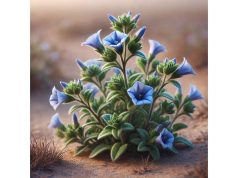Equisetum arvense, commonly known as horsetail, is one of the oldest living vascular plants on Earth, with a lineage that dates back over 100 million years. Revered in traditional herbal medicine and increasingly studied by modern researchers, this remarkable plant is known for its high silica content, potent antioxidant properties, and diverse range of health benefits. Its striking, reed-like appearance and brushy, green stems make it easily identifiable in meadows, along riverbanks, and in damp woodlands. Horsetail has been utilized for centuries to support bone health, promote wound healing, and improve hair, skin, and nail condition, among many other applications. Today, Equisetum arvense continues to be valued both as a natural remedy and a subject of scientific inquiry, bridging ancient wisdom and modern research.
- Supports bone strength and connective tissue health
- Acts as a natural diuretic and detoxifier
- Enhances skin, hair, and nail quality
- Provides antioxidant and anti-inflammatory benefits
- Aids in wound healing and tissue repair
Table of Contents
- Equisetum Arvense: Botanical Profile and Distinctive Characteristics
- Equisetum Arvense: Historical Legacy and Cultural Applications
- Equisetum Arvense: Phytochemical Composition and Bioactive Ingredients
- Equisetum Arvense: Health Benefits and Medicinal Properties
- Equisetum Arvense: Usage Guidelines, Preparations, and Safety Considerations
- Equisetum Arvense: Scientific Studies and Recent Research Insights
- Frequently Asked Questions about Equisetum Arvense
Equisetum Arvense: Botanical Profile and Distinctive Characteristics
Equisetum arvense, or common horsetail, is an extraordinary plant recognized for its unique morphology and ancient evolutionary history. As one of the few surviving members of a once-dominant group of vascular plants, it holds a significant place in both botanical research and traditional medicine.
Morphological Features
Equisetum arvense is easily identified by its distinctive, jointed, hollow stems that resemble a brush or a set of quills. Unlike most modern plants that produce leaves, horsetail has reduced, scale-like structures along its stems. These are not true leaves but are vestigial remnants of a bygone era, underscoring the plant’s ancient lineage.
- Stem Structure: The stems of Equisetum arvense are cylindrical, segmented, and hollow, with finely ribbed surfaces. These ridges not only give the plant its characteristic texture but also contribute to its mechanical strength.
- Reproductive Structures: Horsetail reproduces via spores rather than seeds. Its fertile structures, called strobili, are cone-like formations found at the tips of the stems. These spore-bearing cones ensure the propagation of the species in moist environments.
- Root System: The plant features a fibrous root system that spreads laterally, anchoring it in rocky or sandy soils. This network of roots allows Equisetum arvense to thrive in a variety of habitats, particularly in areas with poor soil quality.
- Habitat Preferences: Typically found in damp or marshy areas, along stream banks, and in meadows, Equisetum arvense is well-adapted to environments where water is abundant. Its preference for moist conditions also underlies many of its traditional medicinal applications, as the plant is believed to aid in the removal of toxins and excess fluids from the body.
Ecological and Ethnobotanical Importance
Historically, Equisetum arvense has been used as a natural remedy across various cultures. Its high silica content makes it valuable not only as a medicinal herb but also in natural gardening practices, where it has been used to strengthen plant cell walls and improve soil health. The plant’s ability to accumulate minerals has led to its use in compost teas and organic fertilizers, further emphasizing its ecological benefits.
Moreover, horsetail is considered a living fossil. Fossil records show that its ancestors dominated the landscape during the Carboniferous period, long before the rise of flowering plants. This remarkable history contributes to its mystique and enduring reputation in herbal medicine, where it is often associated with resilience, regeneration, and longevity.
Visual and Sensory Characteristics
When observed in its natural habitat, Equisetum arvense exhibits a subtle yet striking beauty. Its bright green, segmented stems contrast with the darker, moist soil, while the fine textures of its ribbed surfaces catch the light, creating a shimmering effect. Gardeners often appreciate horsetail not only for its medicinal properties but also for its ornamental value in shaded, naturalistic garden settings.
Equisetum Arvense: Historical Legacy and Cultural Applications
The use of Equisetum arvense spans centuries and continents, with a rich history steeped in both practical applications and folklore. From ancient healing rituals to modern herbal remedies, horsetail has been an integral part of natural medicine traditions around the world.
Ancient and Medieval Uses
Long before the advent of modern pharmaceuticals, ancient civilizations recognized the healing potential of Equisetum arvense. Historical texts from Europe, Asia, and North America document its use in a variety of therapeutic applications:
- Diuretic and Detoxifier: Ancient herbalists used horsetail to help the body eliminate toxins, thanks to its natural diuretic properties. It was often brewed as a tea to promote kidney function and flush out impurities.
- Wound Healing: The high silica content in horsetail was believed to strengthen connective tissues and accelerate the healing of wounds. Poultices made from the plant were applied topically to cuts, burns, and abrasions.
- Bone and Joint Health: Early medicinal practices recognized the benefits of horsetail in supporting bone strength and joint integrity. It was frequently recommended for conditions such as fractures and arthritis.
- Hair and Nail Strengthening: Traditional remedies in various cultures included horsetail extracts to improve the condition of hair and nails, leveraging its mineral-rich composition to promote healthy growth.
Cultural Significance and Folklore
In addition to its medicinal applications, Equisetum arvense has been imbued with symbolic meaning in many cultures:
- Symbol of Resilience: Given its ancient origins and ability to thrive in challenging environments, horsetail has long been seen as a symbol of endurance and persistence. It represents nature’s capacity to regenerate and adapt.
- Folk Remedies and Superstitions: In medieval Europe, horsetail was sometimes associated with magic and folklore. It was believed to have protective qualities, warding off evil spirits and bringing good luck to those who carried it.
- Traditional Veterinary Uses: Beyond human medicine, horsetail was also used in traditional veterinary practices. Farmers and shepherds employed it to treat animal wounds and improve the overall health of their livestock.
Transition to Modern Herbalism
While the traditional uses of Equisetum arvense were based largely on empirical observations and folklore, modern herbalists and researchers have begun to validate these applications through scientific study. The resurgence of interest in natural remedies has brought horsetail back into the spotlight, with contemporary studies focusing on its bioactive compounds, safety profile, and potential integration into holistic health regimens.
Today, Equisetum arvense is not only valued for its historical significance but also for its potential to complement modern therapeutic approaches. Its evolution from a folk remedy to a subject of rigorous scientific inquiry exemplifies the enduring relevance of ancient herbal wisdom in addressing contemporary health challenges.
Equisetum Arvense: Phytochemical Composition and Bioactive Ingredients
A closer examination of Equisetum arvense reveals a wealth of bioactive compounds that underpin its medicinal properties. This section provides an in-depth analysis of the phytochemicals present in horsetail, highlighting the scientific basis for its traditional uses.
Major Bioactive Compounds
Equisetum arvense is renowned for its complex chemical makeup, which includes several key constituents:
- Silica: One of the most notable components, silica is present in high concentrations and is credited with strengthening connective tissue, bones, hair, and nails. It also plays a vital role in the synthesis of collagen.
- Flavonoids: These antioxidant compounds help neutralize free radicals and reduce oxidative stress. Flavonoids in horsetail contribute to its anti-inflammatory and antimicrobial properties.
- Saponins: Known for their ability to form soap-like foams in aqueous solutions, saponins in Equisetum arvense have been linked to immune-modulating and cholesterol-lowering effects.
- Alkaloids: Although present in small amounts, certain alkaloids in horsetail may contribute to its overall pharmacological profile, influencing both its diuretic and neuroprotective actions.
- Phenolic Acids: These compounds enhance the herb’s antioxidant capacity and may play a role in modulating inflammatory responses in the body.
- Minerals: In addition to silica, horsetail contains an array of essential minerals such as potassium, calcium, and magnesium. These minerals support various bodily functions, including muscle contraction and bone metabolism.
Mechanisms Underlying Therapeutic Effects
The diverse phytochemical profile of Equisetum arvense enables it to exert a multifaceted therapeutic impact:
- Connective Tissue Support: The high silica content not only strengthens hair and nails but also promotes the synthesis of collagen, thereby enhancing skin elasticity and joint health.
- Antioxidant Defense: Flavonoids and phenolic acids work synergistically to scavenge free radicals, protecting cells from oxidative damage and reducing inflammation.
- Diuretic Action: The presence of saponins and certain alkaloids may help promote diuresis, facilitating the elimination of excess fluids and toxins from the body.
- Anti-Inflammatory Effects: By modulating inflammatory pathways, the bioactive compounds in horsetail can help reduce inflammation, which is beneficial in conditions ranging from arthritis to skin irritations.
- Mineral Supplementation: The naturally occurring minerals contribute to overall metabolic processes and support the maintenance of strong bones and healthy muscle function.
Research Developments and Analytical Studies
Modern analytical techniques have enabled scientists to isolate and quantify the compounds present in Equisetum arvense. Recent studies published in reputable journals, such as the Journal of Ethnopharmacology and Phytotherapy Research, have provided detailed insights into the herb’s chemical composition. For example, a 2018 study highlighted the role of silica in improving bone mineral density and reducing the risk of fractures, while research in 2020 further validated the antioxidant and anti-inflammatory properties of the flavonoids present in horsetail. These studies not only confirm the traditional uses of Equisetum arvense but also pave the way for its potential integration into modern therapeutic formulations.
Equisetum Arvense: Health Benefits and Medicinal Properties
The medicinal properties of Equisetum arvense have been recognized for centuries, and modern science continues to shed light on its extensive range of health benefits. This section details the therapeutic advantages of horsetail and how its bioactive components contribute to overall well-being.
Key Health Benefits
- Bone and Connective Tissue Support:
Equisetum arvense is highly valued for its ability to promote bone strength and connective tissue repair. Its rich silica content helps stimulate collagen production, which is crucial for maintaining strong bones, healthy joints, and resilient skin. - Diuretic and Detoxifying Effects:
The natural diuretic properties of horsetail aid in the removal of excess water and toxins from the body. This cleansing action supports kidney function and helps maintain optimal fluid balance. - Antioxidant and Anti-Inflammatory Actions:
The flavonoids and phenolic acids found in Equisetum arvense help neutralize harmful free radicals. This antioxidant activity reduces oxidative stress and inflammation, potentially lowering the risk of chronic diseases. - Skin, Hair, and Nail Enhancement:
By providing essential silica and minerals, horsetail contributes to improved hair strength, shinier skin, and healthier nails. It is often used in cosmetic formulations aimed at enhancing natural beauty. - Wound Healing and Tissue Repair:
Traditional applications of horsetail include the use of poultices and topical preparations to promote the healing of minor cuts and abrasions. Its anti-inflammatory and tissue-regenerating properties facilitate faster recovery from skin injuries. - Support for Urinary Tract Health:
Its diuretic effect not only helps eliminate toxins but also supports overall urinary tract health by preventing the accumulation of waste products.
Physiological Mechanisms
The synergistic action of Equisetum arvense’s bioactive compounds works on multiple levels:
- Collagen Synthesis Stimulation:
The silica in horsetail acts as a building block for collagen, a protein that is essential for the structural integrity of bones, skin, and connective tissue. - Reduction of Oxidative Stress:
Antioxidants present in the plant neutralize free radicals, thereby protecting cells from damage and contributing to overall longevity. - Inflammatory Response Modulation:
The herb’s anti-inflammatory compounds help regulate the production of inflammatory cytokines, reducing pain and swelling associated with various conditions. - Enhanced Diuresis:
By increasing urine output, horsetail helps flush out toxins and supports the natural detoxification processes of the body.
Integrating Horsetail into a Wellness Regimen
For individuals looking to incorporate Equisetum arvense into their daily health routine, there are several practical approaches:
- Herbal Teas:
Brewing a tea from dried horsetail stems is one of the simplest methods to harness its diuretic and antioxidant benefits. - Liquid Extracts and Tinctures:
Concentrated extracts provide a more potent dosage, suitable for those seeking targeted therapeutic effects. - Capsule Supplements:
Standardized capsules ensure consistent dosing and are convenient for regular use, particularly for supporting bone health. - Topical Applications:
Creams and ointments infused with horsetail extract can be applied directly to the skin to aid in wound healing and reduce inflammation.
In summary, the diverse medicinal properties of Equisetum arvense make it a versatile herb in both traditional and modern healthcare practices, addressing a wide range of health concerns from bone strength to detoxification.
Equisetum Arvense: Usage Guidelines, Preparations, and Safety Considerations
While Equisetum arvense offers numerous therapeutic benefits, its safe and effective use is paramount. This section outlines the best practices for incorporating horsetail into your health regimen, detailing various preparation methods, dosage recommendations, and safety guidelines.
Common Preparations and Dosage Forms
- Herbal Infusions:
One of the most traditional ways to consume horsetail is by preparing an herbal tea. To make this infusion, steep 1–2 teaspoons of dried Equisetum arvense in a cup of boiling water for 10–15 minutes. This method is ideal for supporting diuretic functions and general detoxification. - Liquid Extracts and Tinctures:
Concentrated extracts allow for precise dosage control and are typically taken in small amounts (a few drops diluted in water) up to two times per day. These extracts are preferred by those seeking a more potent therapeutic effect. - Capsule Supplements:
Standardized horsetail supplements are available in capsule form, providing a convenient and consistent dosage. These are especially useful for individuals aiming to support bone health and collagen production. - Topical Formulations:
Horsetail extracts are also incorporated into creams and ointments designed for external application. These formulations can be applied directly to the skin to promote wound healing and reduce inflammation.
Safety Guidelines and Considerations
- Dosage Recommendations:
While Equisetum arvense is generally safe for most adults, it is important to adhere to recommended dosages as excessive intake may lead to side effects such as gastrointestinal discomfort or electrolyte imbalances. - Potential Interactions:
Horsetail may interact with certain medications, particularly diuretics or drugs affecting electrolyte balance. Individuals taking prescription medications should consult a healthcare provider before adding horsetail to their regimen. - Pregnancy and Lactation:
Due to limited research on its effects during pregnancy and breastfeeding, Equisetum arvense should be used with caution by pregnant or lactating women and only under professional supervision. - Allergic Reactions:
Although rare, some individuals may experience allergic reactions to horsetail. It is advisable to perform a patch test when using a new topical preparation and to start with a lower dose when ingesting the herb.
Best Practices for Incorporation
- Start with a Lower Dose:
Begin with a modest amount to assess your body’s response, gradually increasing the dosage as needed. - Source Quality Products:
Purchase Equisetum arvense from reputable suppliers to ensure purity and potency. Look for standardized extracts that have been third-party tested. - Monitor Your Health:
Pay attention to any adverse reactions and discontinue use if symptoms such as dizziness, stomach upset, or allergic reactions occur. - Consult Healthcare Providers:
Especially if you have pre-existing conditions or are on medication, consult with a healthcare professional before integrating horsetail into your routine.
By following these guidelines, you can safely and effectively incorporate Equisetum arvense into your daily health practices, maximizing its therapeutic benefits while minimizing potential risks.
Equisetum Arvense: Scientific Studies and Recent Research Insights
The growing body of scientific literature on Equisetum arvense has helped validate many of its traditional uses, while also uncovering new areas of potential application. This section highlights significant studies and recent research developments that illustrate the herb’s multifaceted benefits.
Key Research Findings
- Bone Health and Osteogenesis:
A study published in 2017 in the Journal of Ethnopharmacology examined the effects of horsetail extract on bone mineral density. Researchers found that the silica-rich composition of Equisetum arvense promoted collagen synthesis and improved bone strength in animal models, suggesting potential applications in the management of osteoporosis. - Diuretic and Detoxifying Effects:
Research featured in Phytotherapy Research in 2018 provided evidence that Equisetum arvense exhibits natural diuretic properties. The study demonstrated that regular consumption of horsetail tea increased urine output and facilitated the removal of metabolic waste, thereby supporting kidney health. - Antioxidant and Anti-Inflammatory Activities:
A 2019 study in Evidence-Based Complementary and Alternative Medicine highlighted the potent antioxidant activity of horsetail flavonoids and phenolic compounds. These compounds were shown to reduce markers of oxidative stress and inflammation, offering a scientific basis for the herb’s use in managing chronic inflammatory conditions. - Wound Healing and Tissue Regeneration:
Preliminary research from 2020 has investigated the topical applications of Equisetum arvense. Findings indicate that the herb’s anti-inflammatory and tissue-repair properties may accelerate wound healing, making it a promising candidate for dermatological applications.
Frequently Asked Questions about Equisetum Arvense
What is Equisetum arvense commonly used for?
Equisetum arvense is used for its high silica content to support bone health, improve skin, hair, and nail quality, act as a natural diuretic, and promote wound healing through its antioxidant and anti-inflammatory properties.
How can I prepare horsetail for consumption?
Horsetail is most commonly prepared as an herbal tea by steeping dried stems in boiling water, but it is also available in liquid extracts, capsules, and topical formulations for various health applications.
Are there any side effects associated with Equisetum arvense?
While generally considered safe when used as directed, some individuals may experience mild gastrointestinal discomfort or allergic reactions. It is advisable to start with a low dose and consult with a healthcare provider if you are taking other medications.
Can Equisetum arvense be used during pregnancy or breastfeeding?
Due to limited research on its safety during pregnancy and lactation, it is recommended that pregnant or breastfeeding women use horsetail only under the guidance of a healthcare professional.
Where can I purchase high-quality Equisetum arvense supplements?
High-quality horsetail products can be sourced from reputable herbal suppliers and health stores. Look for products that have been standardized and third-party tested for purity and potency.
Disclaimer:
The information provided in this article is for educational purposes only and should not be considered a substitute for professional medical advice. Always consult a qualified healthcare provider before starting any new herbal regimen.
If you found this article helpful, please consider sharing it on Facebook, X (formerly Twitter), or your preferred social media platform. Your support helps spread awareness about natural health and holistic wellness!











